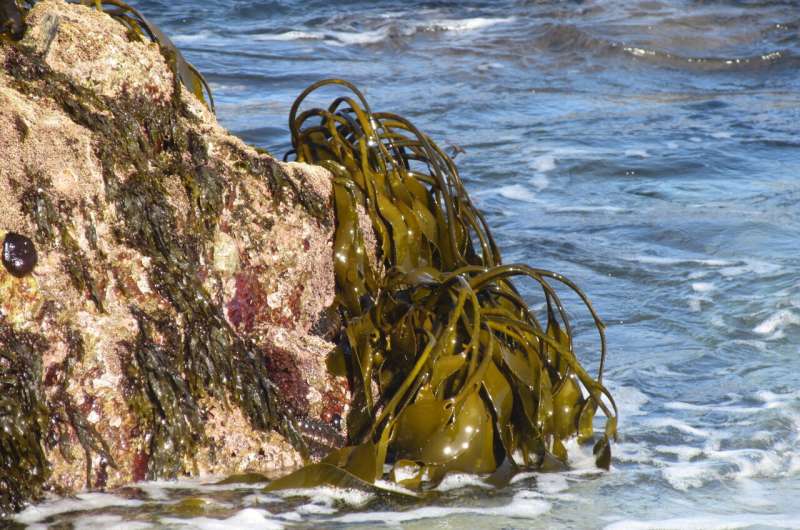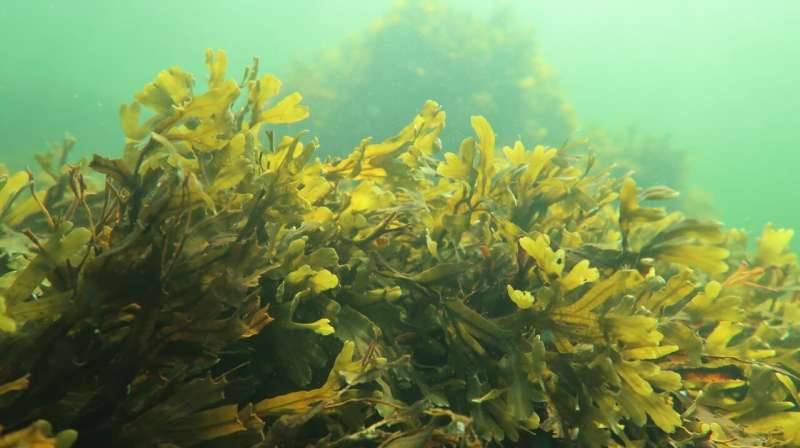Brown algae are particularly widespread on rocky shores in temperate and cold latitudes and there absorb large amounts of carbon dioxide from the air worldwide. Credit: Hagen Buck-Wiese/Max Planck Institute for Marine Microbiology
Brown algae take up large amounts of carbon dioxide from the air and release parts of the carbon contained therein back into the environment in mucous form. This mucus is hard to break down for other ocean inhabitants, thus the carbon is removed from the atmosphere for a long time, as researchers at the Max Planck Institute for Marine Microbiology in Bremen now show.
They reveal that the algal mucus called fucoidan is particularly responsible for this carbon removal and estimate that brown algae could thus remove up to 550 million tons of carbon dioxide from the air every year—almost the amount of Germany's entire annual greenhouse gas emissions.
Brown algae are true wonder plants when it comes to absorbing carbon dioxide from the air. They even outcompete forests on land in this, and thus play a decisive role in the atmosphere and our climate. Researchers at the Max Planck Institute for Marine Microbiology now report in the Proceedings of the National Academy of Sciences (PNAS) that the brown algae can remove large amounts of carbon dioxide from the global cycle in the long term and thus can counteract global warming.
Fucoidan: Brown algae slime is not a favorite dish
Algae take up carbon dioxide from the atmosphere and use the carbon to grow. They release up to a third of the carbon they absorb back into the seawater, for example in the form of sugary excretions. Depending on the structure of these excretions, they are either quickly used by other organisms or sink toward the seafloor.
"The excretions of brown algae are very complex and therefore incredibly complicated to measure," says first author Hagen Buck-Wiese from the Max Planck Institute for Marine Microbiology in Bremen. "However, we have managed to develop a method to analyze them in detail."
With this method, the researchers scrutinized a large number of different substances. The so-called fucoidan turned out to be particularly exciting. "Fucoidan made up about half of the excretions of the brown algae species we studied, the so-called bladderwrack," says Buck-Wiese.
Fucoidan is a recalcitrant molecule. "The fucoidan is so complex that it is very hard for other organisms to use it. No one seems to like it." As a result, the carbon from the fucoidan does not return to the atmosphere quickly. "This makes the brown algae particularly good helpers in removing carbon dioxide from the atmosphere in the long term—for hundreds to thousands of years."
Bladderwrack (Fucus vesiculosus) is also encountered on Germany's coasts, for example on Helgoland. The researchers from Bremen conducted their investigations in Finland. Credit: Camilla Gustafsson, Tvärminne Zoological Station, Finland
Brown algae could bind almost all of Germany's carbon dioxide emissions
Brown algae are remarkably productive. It is estimated that they absorb about 1 gigaton (one billion tons) of carbon per year from the air. Using the results of the present study, this would mean that up to 0.15 gigatons of carbon, equivalent to 0.55 gigatons of carbon dioxide, are sequestered by brown algae each year in the long term. For comparison: Germany's annual greenhouse gas emissions currently amount to about 0.74 gigatons of carbon dioxide, according to the Federal Environment Agency (Umweltbundesamt, estimation for 2020).
"And even better: The fucoidan does not contain any nutrients such as nitrogen," Buck-Wiese explains further. Thus, the growth of the brown algae is not affected by the carbon losses.
Fucus vesiculosus, the bladderwrack, is a perennial plant and grows up to 30 centimeters long. It clings to rocks and other substrates with an adhesive plate. The bladderwrack gets its name from the distinctive spherical gas bubbles that provide buoyancy and are clearly visible in this picture. Credit: Hagen Buck-Wiese/Max Planck Institute for Marine Microbiology
More species and sites
For the current study, Buck-Wiese and his colleagues from the MARUM MPG Bridge Group Marine Glycobiology, which is based at both the Bremen Max Planck Institute and MARUM–Center for Marine and Environmental Sciences at the University of Bremen, conducted their experiments at the Tvärminne Zoological Station in southern Finland.
"Next we want to look into other brown algae species and other locations," says Buck-Wiese. "The great potential of brown algae for climate protection definitely needs to be further researched and utilized."
More information: Buck-Wiese, Hagen et al, Fucoid brown algae inject fucoidan carbon into the ocean, Proceedings of the National Academy of Sciences (2022). DOI: 10.1073/pnas.2210561119. doi.org/10.1073/pnas.2210561119
Journal information: Proceedings of the National Academy of Sciences
Provided by Max Planck Society


























